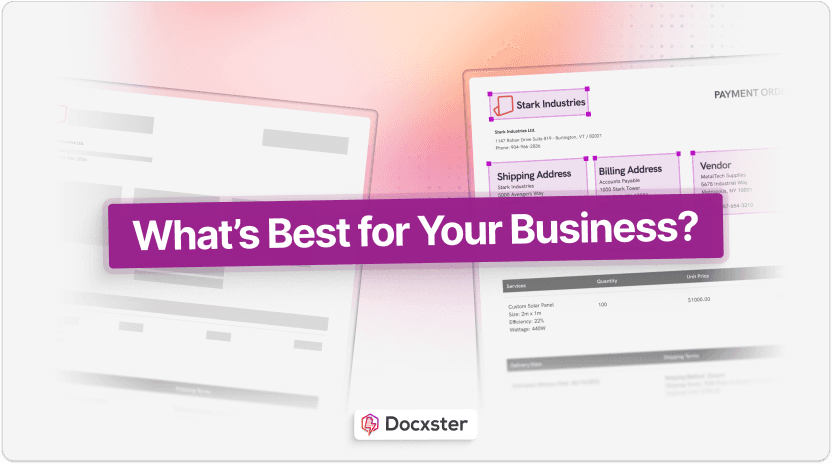
Template-based solutions look easy to start with, but templateless ones sound more flexible.
Template-based solutions assure speed, but templateless ones promise accuracy.
Template-based solutions have been in the market for a long time, but templateless ones are the current hype, growing at a rate of 30.1% CAGR.
Making a decision like this can be challenging, and we're here to help. In this article, we'll compare template and templateless data extraction in detail to help you make the choice.
What is template-based extraction?
Template-based extraction process is a method of extracting relevant information from documents based on predefined templates. In this method, the tool locates different data fields using existing document templates as a reference.
This approach works very well when you're using documents with a clear-cut template. For example, a PAN card, a bank statement, or a standard invoice format.
On the other hand, many businesses try to create their own templates and force vendors to adopt it in a bid to standardize. They use template-based extraction for these standardized documents only. But as they onboard more vendors, this process becomes an uphill battle.
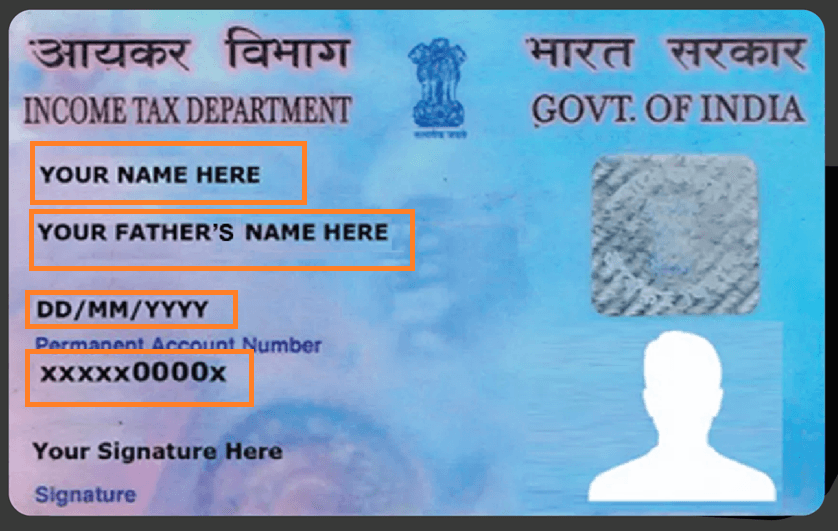
Template-based extraction of a standardized document | Source: Zwitch
What is templateless extraction?
Templateless extraction is a flexible and scalable method for extracting information from documents without relying on predefined templates. It moves beyond rigid formats and reads documents using machine learning, deep learning, and natural language processing.
This approach works best when you’re dealing with documents that are tough to box in a format. For example, vendor invoices, bills of lading, and procurement contracts.
You could start with templates initially. But with scale, it becomes tough to maintain and enforce templates as more and more vendors/suppliers come into the picture. One vendor changes the invoice format, and the entire process breaks. That’s when businesses shift to templateless extraction.
As more businesses are dealing with different document types, they're moving towards templateless extraction. One of the biggest examples is Uber. Uber was facing challenges processing thousands of invoices everyday. Whenever they came across a new document template, someone had to review it manually.
As a result, their payments got delayed, leading to frustrated vendors. It no longer made sense to stick to template-based extraction. That’s why they switched to templateless extraction, and it cut down their invoice processing by 70%.

Templateless extraction of unstructured content
What are the differences between template-based and templateless extraction?
The choice between template and templateless extraction isn’t just a business decision but also a strategic one. It impacts your operational efficiency.
To help you make an informed decision, we’ve compared key performance indicators (KPIs) that impact your business.
TL;DR:
Accuracy
The concept of template-powered extraction dates back to the 1970s and more solid research coming in the late 1990s. Despite being in practice here for decades the technology still struggles to meet accuracy standards. The primary reason is the way it functions.
A vendor changes ‘Invoice amount’ to ‘Total amount' in their invoice structure, and the entire system breaks. Accuracy runs on a tight rope of everyone making sure every party involved doesn’t make any mistake or changes.
Compared to template-based systems, templateless extraction is way more adaptable. These solutions use Natural Language Processing (NLP) and Computer Vision to interpret and extract data. It doesn’t just scan a document. It actually interprets it to understand context. And then pulls exact information with high accuracy.
Businesses are shifting towards templateless extraction to improve accuracy, create more dependable workflows, and reduce human intervention.
For instance, a large financial services company was processing a variety of documents. The traditional template-based extraction tools could not handle it. They adopted AI-based extraction, which doesn't rely on any templates, and that shift alone improved overall accuracy and reduced manual effort by ~ 40%.
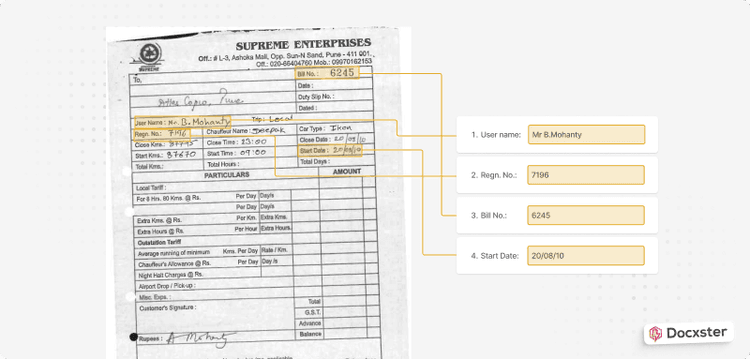
Templateless extraction of a handwritten invoice using Docxster
Setup time
In a template-based approach, you've got to reach out to developers to design the template and set up the workflow. They'll take their time understanding the document, building templates, and developing/testing the workflow.
It’s a time-consuming setup that can take anywhere from days to weeks. The duration depends on document complexity and the availability of developers.
On the other hand, templateless extraction workflows are often ready in hours. For instance, Docxster platform just needs the document location and potential field names (not exact names, but something that AI can refer to) you want to pull to create an extraction workflow.
There are minimal configurations. And even those configurations can be done in the user interface by clicking a few buttons. Templateless extractions enable you to create workflows faster, onboard new documents easily, and respond quicker to changes.
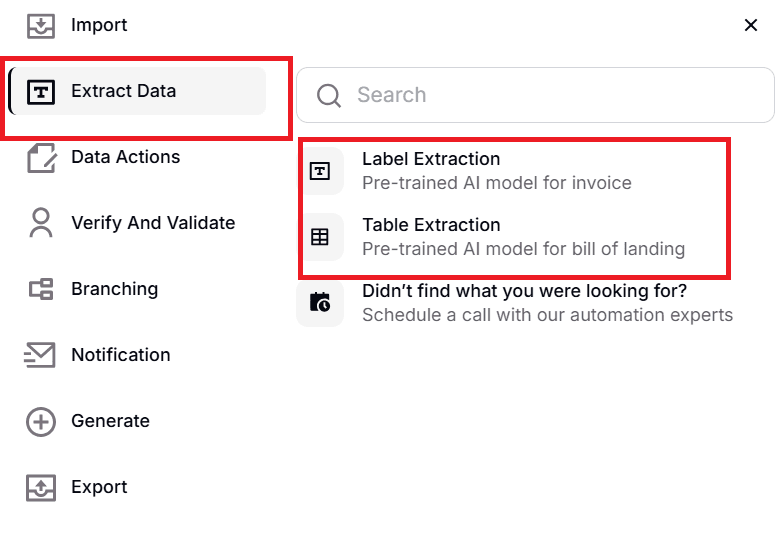
Docxster offer a simple console to design any templateless workflow
Labor cost
Template-based extraction is more resource-heavy. You need support from developers to design any new template. The cost varies depending on whether you have full-time developers or take support from freelancers/agencies.
Skilled ML engineers work at an hourly rate of ₹1014.70 per hour. Having even one engineer full-time means a recurring cost of ₹162352.
Taking support from the agency means you’d be paying for the number of hours worked or a fixed package based on the expected time involved. Imagine it took approximately a week and 56 work hours for an automation then cost is ₹1014.70*8*7= ₹56823.2 per automation.
On the other hand, templateless solutions offer a no-code automation interface. Anyone from your team can start creating workflows by taking out a couple of hours. You need not maintain a separate team for simple workflows.
Training cost
To adopt a template model, you need to train staff on:
- Developing new document templates
- Creating new document workflows
- Handling changes as new document types roll in
On the flip side, templateless extraction requires minimal to no training. It comes with an intuitive interface that anyone can run from day one. A quick walkthrough of the platform may be enough. Otherwise, the training cost is close to zero.
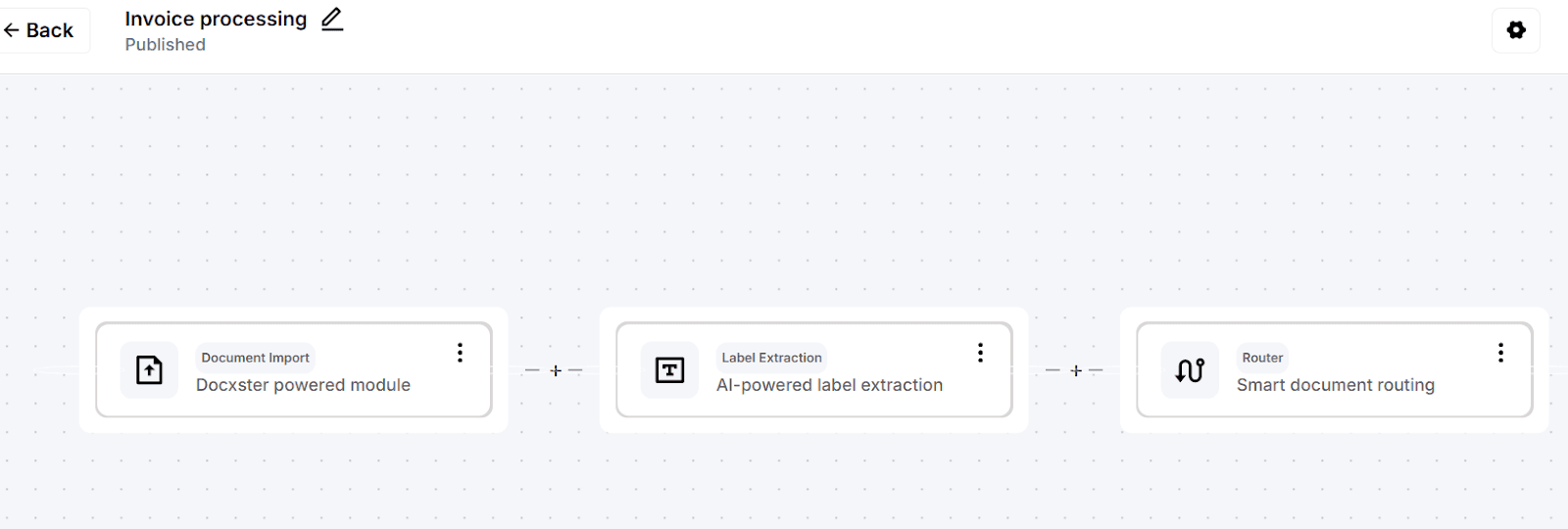
Simple invoice data extraction workflow built in Docxster by drag-and-drop interface
Processing speed
Template-based optical character recognition (OCR) already knows document layouts by referencing templates. This predictability reduces the processing time. Alternatively, templateless models run complex AI/ML pipelines to understand and break down documents. This complexity increases model run time by a few seconds.
There is also a flip side to it. Template-based extraction models break when any document deviates from the template. And at a large scale, they often do.
For example, Lawrence Guyot, President, ETTE, a managed IT consultancy, says around 25% of their documents deviate from standard templates. In the event of deviation, manual intervention is necessary to accurately extract the data.
At the individual document level, a template-based OCR system would run fast for you. But in the larger scheme of things, templateless extraction workflows will handle scale better when your company grows.
Infrastructure cost
As many template-based extraction solutions often run on-premises, they come with an additional requirement of server costs. It’s costly to maintain servers.
High-range servers cost upwards of ~₹77,000 per month. On top of it, there are additional costs of electricity, maintenance, and software licenses.
Templateless platforms like Docxster (which runs on the cloud) prove to be way more affordable. You get plans starting at $45 per month and save on the cost of maintaining internal infrastructure.
“With the advent of LLMs, templateless technology is getting more democratized. While it was earlier largely available for big enterprises, now small and medium-sized enterprises can also easily afford it.” ~ Ramzy Syed, Founder, Docxster
Integrations
Template-based solutions provide APIs to integrate with your current tech stack and upload data. You need developer support to configure these APIs in the workflow for integration for work.
Templateless platforms make it simple with built-in integrations with multiple systems. For example, Docxster provides quick and seamless integrations with popular ERP and CRM. All you need to do is is connect your platform of choice through APIs or in-built integrations to activate it. Your data is well and easily integrated in the entire ecosystem with built-in integrations.
Maintenance cost
A major maintenance cost of template-based extraction solutions is having developers onboard to handle tweaks in existing documents or add any new documents.
Jishnu N, Docxster’s chief technology officer says that it’s tough for businesses to maintain a team of developers to handle these changes and additions. The primary reason is that the work is irregular.
Not every day a new document gets added to the system, nor every day does any existing template break. So, having a dedicated team for it doesn’t make sense economically. It’s also a waste of resources.
Templateless solutions are low-maintenance cloud solutions. Business teams can make changes themselves if any new field is added to a document or if something is dropped. It eliminates the need to maintain skilled engineers for document handling and processing.
Flexibility
Template-powered extraction is rigid. Imagine one vendor suddenly changes a field in the invoice from ‘Invoice Amount’ to ‘Bill Amount’. This tiny change breaks the entire system, putting you at risk of delayed payments and contract clause violations.
On the other hand, templateless extraction is more fluid and ready to handle different document formats without major pre-handling steps. With templateless workflows, your business is already prepared to onboard a new vendor or process a rare contract.
Scalability
It’s easy to add any new workflows in a templateless system with simple drag and drop. Also, these solutions often run on subscription models, so scaling means just upgrading subscription plans.
In a template-based approach, any change requires developer support. Either you need to build a team of developers or hire a reliable vendor for timely support. There is heavy dependency on developers to scale and time-consuming setup involved for templates.
Also, if your current computing resources aren’t enough, then you need to plan additional CPUs/servers and storage to handle the scale. All these factors make scalability tough in template-based extraction.
Return on investment
The return on investment (ROI) of template-based solutions is high for small and static documents initially. But it drops in the long run, ROI becomes low when considering the cost of:
- Labor cost for handling any document changes
- Labor cost for adding new document workflows
- Infrastructure to run workflows
Templateless solutions have much stronger long-term ROI as it’s easy to start with and easy to maintain, and cloud storage also keeps the cost down.
“2025 is a breakthrough year for templateless extraction models. Earlier, these models were only financially accessible to developed countries. But now the cost of extraction has gone down to a level that it’s not only more accessible to developing countries, but the ROI is also high. It's the best time for Indian businesses to start adopting this technology.” — Jishnu N., Chief Technology Officer of Docxster
Security
Typically, businesses have trusted only on-premise template-based solutions. It gave more control over their data and assurance of compliance. But that also means IT teams spend extra time on setting up and following security protocols.
Nowadays, even cloud-based templateless solutions are secure, so you don't have to stick with on-premise platforms.
For instance, Docxster is a cloud-based templateless document automation platform. But we’re certified as per GDPR and ISO 27001 standards. So, irrespective of your compliance requirements, you can feel confident while using our platform. Plus, all the compliance standards are built in, reducing the extra work for IT teams.
Why are businesses moving towards templateless extraction?
As Jishnu said, now is the best time to shift towards templateless extraction due to high ROI. But that’s not the only reason for the shift.
Another key reason is the rise of unstructured and multimodal data. Ninety percent of an organization's data is unstructured. Since many business documents are no longer limited to a fixed layout, processing only documents with predefined templates will cause you to miss most of the important information.
If you’re planning to shift from template-based to templateless solutions, the primary task is to choose a software platform to make the move. You can follow this simple checklist to find the right solution:
 Does the solution use the latest technologies offering high accuracy?
Does the solution use the latest technologies offering high accuracy? Is the platform easy to use?
Is the platform easy to use? Can the platform handle structured, unstructured and multimodal data?
Can the platform handle structured, unstructured and multimodal data? Can the platform support scanned or handwritten documents?
Can the platform support scanned or handwritten documents? Does it support matching data across multiple document types in a workflow?
Does it support matching data across multiple document types in a workflow? Is the pricing in your budget?
Is the pricing in your budget? Does it comply with your industry’s security standards?
Does it comply with your industry’s security standards? Can it be integrated into your current tech stack?
Can it be integrated into your current tech stack? Does it offer reliable customer support?
Does it offer reliable customer support?
Once you have identified the solution, you can start moving your documents one by one from the existing setup to the new platform.
Future-proof your business with templateless extraction
The dilemma between template and templateless is real.
Businesses tend to start with a template-based solution and keep templateless in the pipeline when things scale. But given how affordable templateless technology has become, it makes sense to adopt it from the beginning.
You’re ready to handle sudden scale, variations in documents, unstructured documents, and multimodal data.
Looking for a reliable solution that checks all the boxes?
Docxster is a future-proof document processing solution that can handle new types of documents with no additional effort. Schedule a quick demo to get a complete package for all your document processing needs.
Get Document Intelligence in Your Inbox.
Actionable tips, automation trends, and exclusive product updates.


